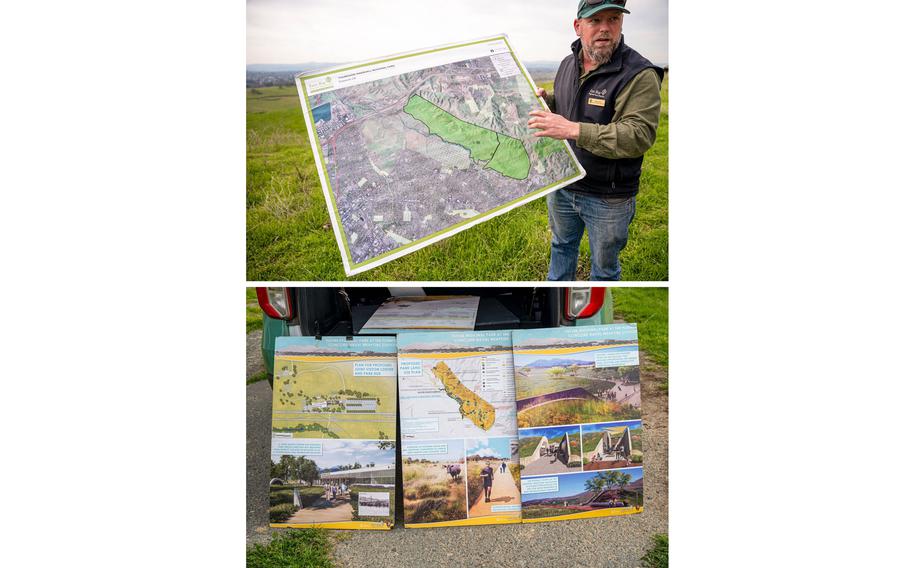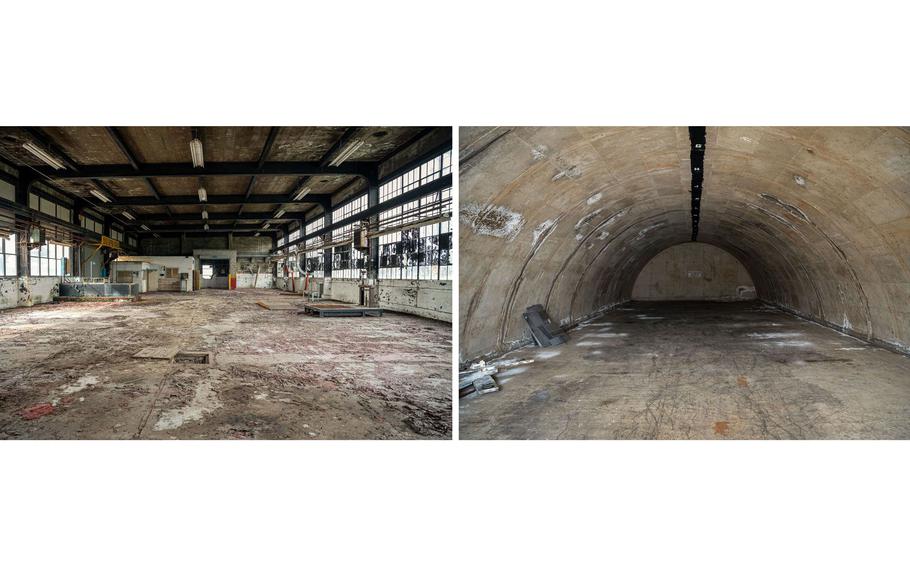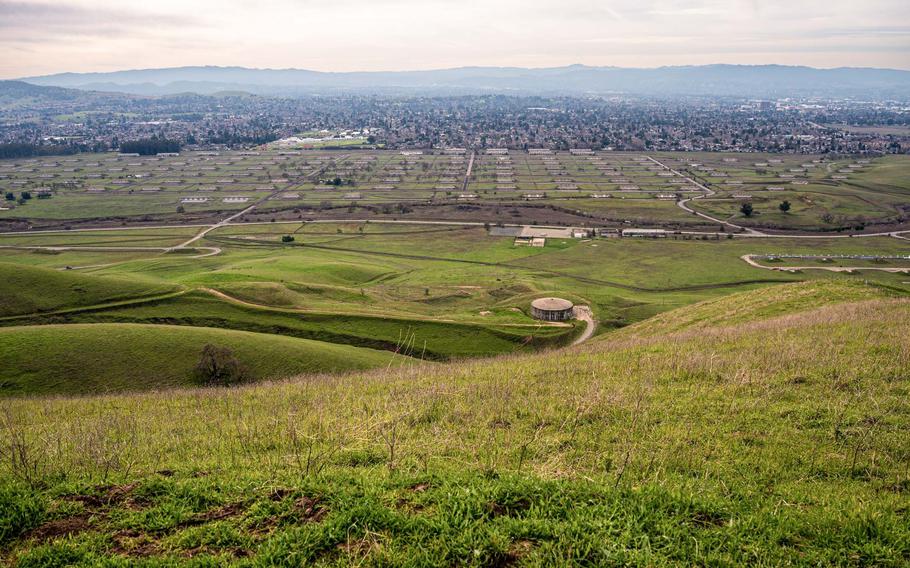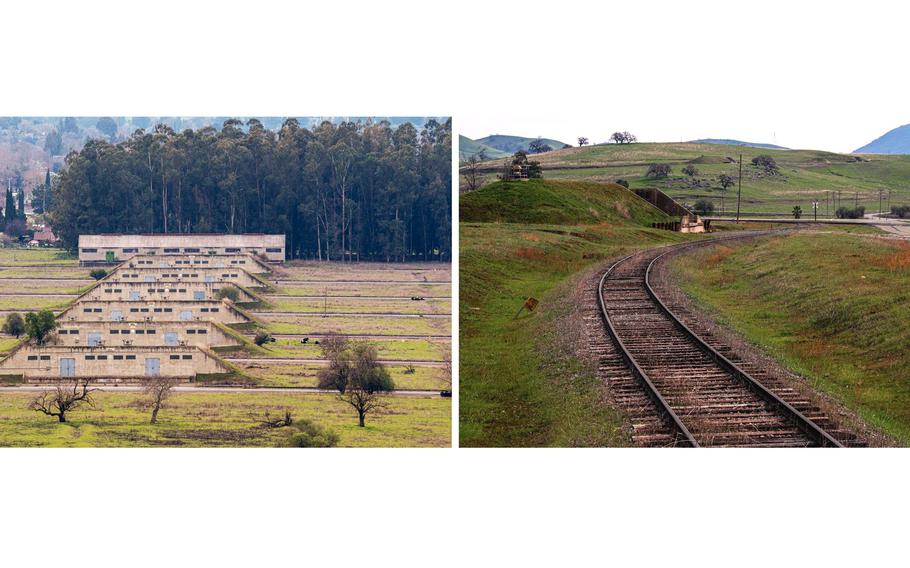
Brian Holt, chief of planning at the East Bay Regional Park District, is in the process of transforming 2,216 acres of the site into parklands. (David Paul Morris/Bloomberg)
On an overcast February day, futuristic autonomous shuttles roll silently through deserted streets past decaying, abandoned buildings on the northern fringes of San Francisco Bay. The only signs of life are a phalanx of police officers and, in the distance, cattle roaming among hundreds of sod-covered concrete bunkers that stretch to the horizon.
Nearly two decades after the U.S. Navy decommissioned the Concord Naval Weapons Station in California, the sprawling site more resembles the set of a post-apocalyptic movie than the residential community it’s slated to become. Before ground is broken on a single new home, bunkers, pipelines and other military infrastructure must be removed, and electricity, water and other utilities will have to be extended to an area a third the size of Manhattan. Efforts to secure a master developer for the project are dragging, though, and for now the former base is being used as a testing ground for self-driving electric vehicles and to train law enforcement personnel.
The convoluted quest to repurpose the Concord Naval Weapons Station underscores the challenges of redeveloping a vast but contaminated military facility, as well as the unique opportunity. The city of Concord’s plans for the 4,972-acre base call for more than 12,000 homes along with businesses, schools and sporting facilities to be built adjacent to existing mass transit. More than half the base will become a 2,543-acre park, which will preserve habitat for endangered animals and connect people and wildlife to a network of regional preserves. The base essentially offers a once-in-a generation chance to significantly expand housing stock in a region suffering a severe home shortage, while also minimizing climate impacts from suburban sprawl.
“There’s an emphasis on lowering greenhouse gas emissions and making it a transit-oriented development that is pedestrian and bicycle-friendly with higher densities around the train station,” said Guy Bjerke, Concord’s director of economic development and base reuse.

Left: A building where the base’s forklifts used to be serviced will be rehabilitated as the park visitors center. Right: The interior of an ammunition bunker. (David Paul Morris/Bloomberg)
The naval weapons station has remained off limits to the public for nearly 80 years and the Navy retains ownership until the city executes a viable deal with a developer. In 2019, though, the Navy transferred 2,216 acres of the site to the East Bay Regional Park District, which is in the process of transforming the parcel into parklands.
Driving along Mount Diablo Creek, which divides the future Thurgood Marshall Regional Park from the planned housing development, a dirt track climbs through grasslands into the Los Medanos Hills. Coyotes roam the ridgeline, where there are sweeping views of Mount Diablo, the Bay Area’s highest peak, and 118 grass-roofed ammunition bunkers linked by railroad tracks (dubbed “Bunker City”), plus a squat building where fuses were once attached to bombs. On a clear day, the Sierra Nevada Mountains can be seen more than 100 miles to the east.
The view a few miles to the north is of Port Chicago, where the Navy established an ammunition depot on Suisun Bay in 1942. After a munitions explosion killed 320 primarily Black sailors in 1944, some of the survivors were court-martialed when they refused to return to work. NAACP attorney Thurgood Marshall, the future Supreme Court justice and the park’s namesake, was a leading advocate for the sailors.
After that disaster, the Navy purchased nearby farms and ranchland to establish the Concord Naval Weapons Station, over time adding rocket-testing ranges, missile-assembly buildings and burn areas where munitions were exploded and buried. That left grasslands and groundwater contaminated with pesticides, arsenic, carcinogens and other hazardous materials.
The weapons station was one of dozens of military facilities shuttered following the end of the Cold War. The Navy officially departed the base in 2008 and made it available to the city of Concord for redevelopment. Environmental remediation and the presence of endangered species required years of consultation and coordination with an array of government agencies; the city also spent years soliciting community input until formally adopting a reuse plan in 2012.

The biggest hurdle has been finding a developer with deep pockets and enough patience to finance and build what amounts to a $6 billion new city. (David Paul Morris/Bloomberg)
The biggest hurdle, though, has been finding a developer with deep pockets and enough patience to finance and build what amounts to a $6 billion new city. Concord chose Lennar as the master developer in 2016, but the company couldn’t reach a labor deal with unions and dropped out of the project in 2020. The city then selected a consortium as the new master developer in 2021, only to sever ties in February when it couldn’t agree to terms.
“It’s a 40-year project,” Bjerke said. “We are trying to come up with a master developer who can meet community expectations, which are pretty high, and make the project work financially.”
The military seems willing to wait. “The Navy supports the city and its ongoing reuse efforts,” William Franklin, a spokesperson for the Navy Base Realignment and Closure Office in San Diego, said in an email, noting that the Navy “retains the authority to make final property disposal decisions.”
The Navy is responsible for environmental remediation and Franklin says 1,288 acres of the 2,350 acres set aside for the new community have been cleaned up and are “ready for immediate transfer” to the city. The remaining 1,062 acres still need to be fully restored, a process that will be completed in phases between 2024 and 2030.

Some 118 grass-roofed ammunition bunkers, linked by railroad tracks, are known as “Bunker City.” (David Paul Morris/Bloomberg)
Throughout the rolling hills of the park site, too, fenced-off areas demarcate land that is still contaminated. “Our side of the property was, from a military perspective, relatively clean,” said Brian Holt, chief of planning at the East Bay Regional Park District. He notes that the 327 acres still in need of cleanup are in relatively small, isolated patches.
Current plans call for most of the 50 ammunition bunkers on the park site to be repurposed as picnic areas, exhibit space and for other uses, their grass roofs seeded with native wildflowers. The barrel-vaulted bunkers already provide habitat for some critters — a ground squirrel pops its head out of a burrow dug into the roof of one — and the future park is home to the California tiger salamander, the California red-legged frog and other imperiled species.
“A lot of what we’re doing in this first phase is undoing: removing roads and pavements and converting rail lines to hiking and biking trails to increase species habitat as well as adding minimal amenities for people,” said Eva Rose Leavitt, a landscape architect for the park district. A dilapidated building with walls of windows, where the base’s forklifts were serviced, is likely to be rehabilitated as the park’s visitor center.
An 890-acre southern portion of the site with less infrastructure and contamination to remove could open as soon as 2025, and officials have begun giving walking tours of the future park. “For a piece of property this big that’s been closed off from the public since the ‘40s, people are just excited to get out and see it,” Holt said.